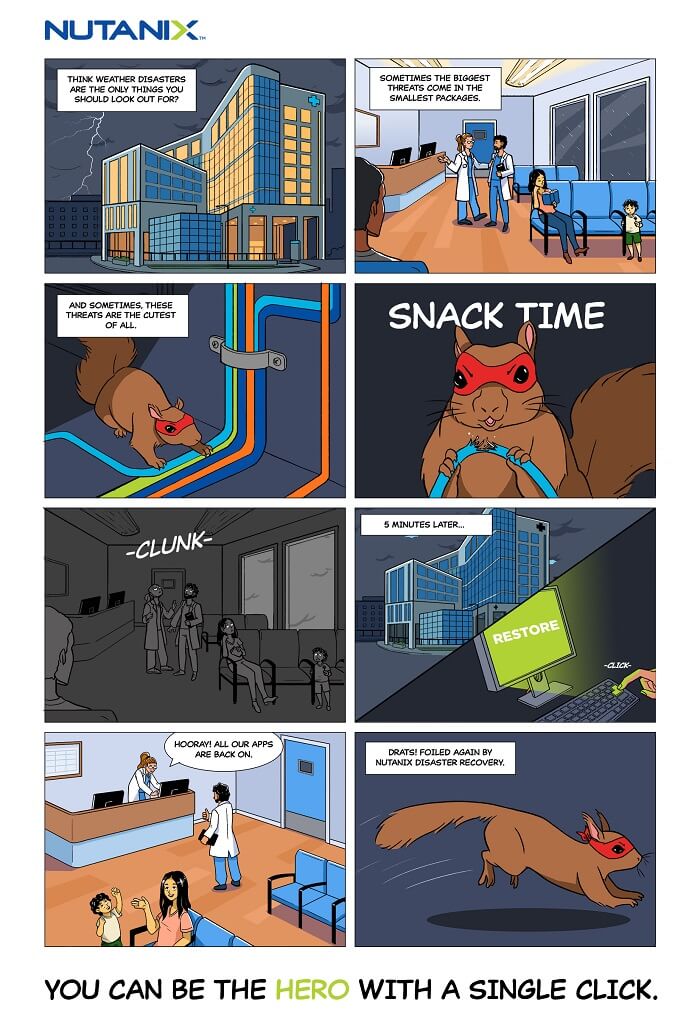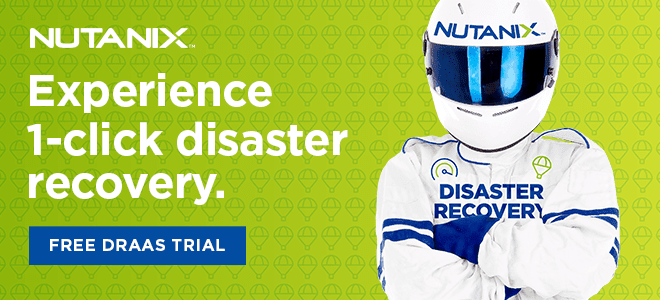The dangers seem boundless, from ransomware to climate change. Cloud-based technologies can help fine-tune your business continuity and disaster recovery (BCDR) plan and avoid those seemingly endless dangers (and recover quickly, if needed).
When CIOs started taking the cloud-first plunge, many made the decision to back up everything to the public cloud where storage is infinite, said Dan Angst, Director of Data Center Sales at Nutanix, which specializes in enterprise cloud management software.
“Then they started to realize that renting the penthouse is a heck of a lot more expensive than buying the penthouse,” Angst said. “Even the manpower it took to run out in the public cloud was about the same as the manpower it took to run your own data center.”
He said this led many IT organizations to build a hybrid multicloud data operation.
While the public cloud offers limitless storage, CIOs do not enjoy unlimited BCDR budgets. Studying the situation and talking with customers, Ed Collins, principal solutions product manager at Nutanix, learned some IT best practices for disaster recovery.
“Keep total cost of ownership to a bare minimum while amplifying critical must-haves,” Collins said.
Cloud-based technologies give companies the tools to fine-tune their BCDR programs to save money, preserve IT uptime and protect their brand reputations. In an interview with The Forecast by Nutanix, Angst and Collins talked about what it takes to develop custom BCDR strategies. They spelled out four essentials to creating a custom BCDR plan.
Start with the Big BCDR Picture
Building a strategy is the first step in developing a BCDR plan, according to Angst.
“People who actually have a plan are so far ahead of most businesses,” he said. “Having a meeting to start planning is the biggest step — and the hardest step. Once you do that, it becomes a lot easier because at least you're thinking about it.”
Implementing a BCDR plan starts with establishing priorities for protecting applications and data. “Maybe not all of my applications really need to come up” right away, Angst said.
Human resources data would likely have lower priority, for instance, than an ecommerce app.
“But I need to protect the application where people buy my product, and that needs to be up all the time,” said Angst.
When developing a BCDR program, companies must assess the cost of IT system downtime — because digital technology is woven into every corner of most organizations. Angst said the central question is: How much is it going to cost if all those systems go away and all that data goes away, and you have no way to bring it back up?
“So, disaster recovery has to be part of your business plan, period,” he said.
Nutanix helped pioneer the concept of virtualizing compute, storage and networking in a single software package called hyperconverged infrastructure (HCI). With HCI, it’s easy to spin up development, testing and backup environments, which helps companies develop tiers of disaster recovery driven by business priorities.
Before moving to HCI in 2019, Penn National Insurance allowed its employees to work from anywhere, using virtual desktop infrastructure (VDI) powered by a traditional 3-tier IT system. But it quickly became costly to scale.
By 2021, they were operating a hybrid cloud IT operation that delivered virtual desktops to over 850 employees and 100 international developers across the company. Nutanix Clusters allows them to move applications and data from their private cloud to their public cloud on Amazon Web Services (AWS). With these capabilities, Penn National Insurance was able to simplify VDI management and re-architect its BCDR process.
Create Tiers of Disaster Recovery
One core advantage of HCI is using automation to simplify and rationalize extremely complex IT systems. It’s a breakthrough technology because it paves the way to hybrid and multicloud Infrastructures that mix and match the best features of private and public clouds. HCI software lets IT leaders wrangle all these moving parts from a central user interface. When it’s time to build a disaster recovery program, HCI makes it easy for IT leaders to develop their DR systems in tiers. Angst explained that Nutanix can help companies decide exactly where they want their data and applications to failover to.
Collins added, “With the advent of what we would call multisite disaster recovery solutions, we have the ability now to failover to not just one site, but multiple sites.” One application might require real-time failover while another could be recovered in minutes, hours or days, depending on the company’s specific needs.
Some companies find their applications and data work best when failover goes to the public cloud. Other data and apps might be better off targeting a data center in a different geographic location, on infrastructure owned by the company. IT leaders don’t have to run five separate disaster recovery applications, Angst said, because they can run it all through software like Nutanix’s HCI platform.
Collins noted that in a multicloud world, Nutanix’s customers can choose to back up to their own secondary data center (a private cloud) or to the public cloud. Another option is disaster recovery as a service (DRaaS), where a third party oversees all aspects of a BCDR program.
“And it's offered up as a single subscription to the customer,” Collins said.
This sets the stage for drilling down into even more customizations.
Get Granular at the Policy Level
Most companies have limited budgets, so they want to devote the most data protection and disaster recovery resources to the most mission-critical applications and data.
“One of the nice things about today's technology is that you're able to use these granular-level constructs, such as protection policies, and group categories of virtual machines (VMs) together to facilitate application prioritization,” Collins said.
“In a simple way, you might think of an application that has a backend database,” he added. “Well, you want those two VMs to be ganged together in a single protection policy.”
If the business depends on keeping that application running all the time, then BCDR policies can be honed to deal with that need.
“And so, you have this sort of built-in prioritization in terms of protecting your applications,” Collins said.
“Because you have these tools available to you in these DR solutions, you're able to stratify applications and only spend the maximum amount of money when required to protect certain business-critical applications.”
This becomes even more paramount as recovery objectives get tighter. The latest generations of recovery tools are helping companies shrink their downtime windows. A Nutanix customer, for instance, realized a 24-to-1 improvement in recovery point objectives and a 2-to-1 boost in recovery time objectives.
Precise specialization helps IT managers craft nuanced BCDR programs that optimize the total cost of ownership (TCO) of a solution.
“I think that's a really powerful story with today's technology, compared maybe to the old days where you just failed over an entire data center, and that was it,” Collins said.
Be Ready for Anything
Collins recalled one of the most unusual reasons for system downtime he has encountered:
“Everybody thinks of DR as a natural disaster, but we actually had a customer that had a rodent chew through wires in a data center and brought the data center down.”

Angst observed that disasters come in many shapes and sizes. “Disaster recovery isn't just Mother Nature, it's not just a hurricane, a flood or a fire,” he said. “It's cyberattacks. It's also human error.”
IT leaders need to spell out the full scope of IT downtime risks when pitching the C-suite to fund a modern BCDR program, especially as the cost of downtime grows. In 2021, ransomware attacks alone cost an estimated $20 billion worldwide. Angst noted a widely quoted estimate from Gartner Inc. that IT downtime costs businesses an average of $300,000 per hour.
Angst concluded: “When you can go up and say, ‘The financial benefit of this is that downtime on average costs about $750,000,’ even the CFO goes, ‘Okay, that makes sense to me. That's something that I can sell to the board’."
This is an updated version of the article originally published on May 20, 2021.
Tom Mangan is a contributing writer. He is a veteran B2B technology writer and editor, specializing in cloud computing and digital transformation. Contact him on his website or LinkedIn.
Jacob Gedetsis contributed to this article. His work has appeared in The Kansas City Star, The Post Standard and The Plain Dealer, among others. Find him on Twitter @JacobGedetsis.
© 2021 Nutanix, Inc. All rights reserved. For additional legal information, please go here.





